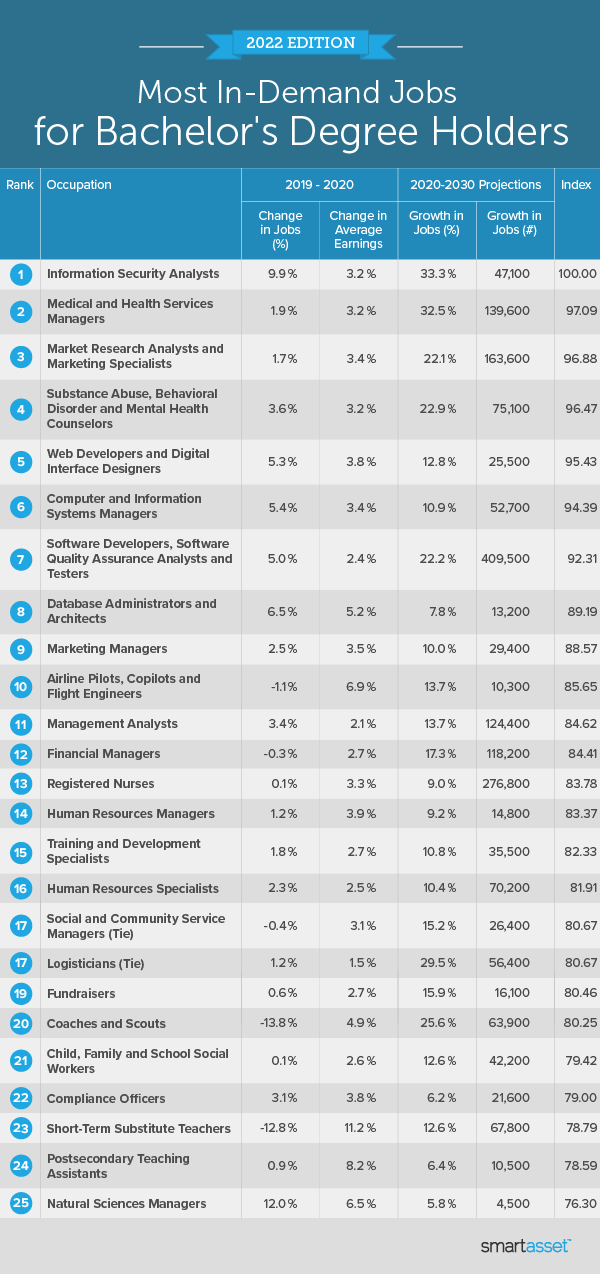In 2021, millions of Americans voluntarily left their jobs every month in what is now called the “Great Resignation.” Some were burnt out, while others quit to look for better pay or new careers. A total of 4.4 million people left their jobs in September alone, raising the quit rate to 3%, the highest it’s been since the Bureau of Labor Statistics first published the figure in 2000.
With so many American workers considering career changes, we set out to identify the most in-demand occupations for workers who hold bachelor’s degrees. We examined BLS data from 150 professions and compared them across the following metrics: percentage change in average earnings from 2019 to 2020, percentage change in employment from 2019 to 2020, projected employment change from 2020 to 2030 and projected percentage change in employment from 2020 to 2030. For details on our data sources and how we put all the information together to create our final rankings, check out the Data and Methodology section below.
This is SmartAsset’s fourth annual study on the most in-demand jobs for bachelor’s degree holders. Check out the 2021 rankings here.
Key Findings
- Tech and health jobs reclaimed the top 10. Information security analysts, medical and health services managers, and computer and information systems managers are the only three jobs from last year’s list to rank in the 2022 top 10. Comparatively, producers and directors, which ranked first in 2021, fell all the way to 39th in this year’s study.
- There’s a surprising earnings jump in teaching. Short-term and substitute teachers saw the largest increase in average earnings between 2019 and 2020, rising 11.2%. However, employment for this occupation fell 12.8%, the ninth-steepest drop-off for the metric.
- Computer and IT careers are in high demand. Five out of the 10 occupations at the top of our rankings are in the computer or IT industries. The five careers all rank in the top 15th percentile for percent change in employment from 2019 to 2020.

1. Information Security Analysts
Information security analysts, professionals who monitor and upgrade the security of computer networks, are the most in-demand workers with bachelor’s degrees. The occupation ranks second overall for its projected percent growth between 2020 and 2030 (33.3%) and fourth for percent change in employment between 2019 and 2020 (9.9%). According to BLS projections, there will be 47,100 more information security analysts in 2030, the 18th-most across our study.
2. Medical and Health Services Managers
Medical and health services managers are responsible for planning and coordinating care in hospitals, clinics and other organizations. The BLS predicts this occupation will grow by 32.5% between 2020 and 2030, the fourth-highest projected increase in that timespan. The federal agency also projects 139,600 new positions within in the field in the next decade, the fifth-most across our study.
3. Market Research Analysts and Marketing Specialists
Market research analysts and marketing specialists jumped up 10 spots from last year when the occupation ranked as the 13th-most in-demand for workers with bachelor’s degrees. Between 2020 and 2030, the BLS expects there will be 163,600 new market research analysts and marketing specialists in the workforce, the fourth-largest increase of all 150 occupations in our study. This profession will also grow by 22.1% in that same time period, the 15th-largest projected increase across our study.
4. Substance Abuse, Behavioral Disorder and Mental Health Counselors
Counselors who specialize in substance abuse, behavioral disorders and mental health rank within the top 20 for three separate metrics. According to BLS projections, the field is expected to add 75,100 new jobs between 2020 and 2030, the 11th-most across our study. By 2030, there will also be 22.9% more counselors who deal with substance abuse, behavioral disorders and mental health (the 13th-largest increase). Meanwhile, the occupation was tied for having the 16th-largest percentage increase in employment between 2019 and 2020, when it grew by 3.6%.
5. Web Developers and Digital Interface Designers
The occupation of web developers and digital interface designers grew by 5.3% between 2019 and 2020, the 10th-largest increase during that time period. The profession is also expected to continue growing. The BLS projects the field will expand by 12.8% by 2030, the 29th-largest percent change across our study.
6. Computer and Information Systems Managers
Between 2019 and 2020, employment in this tech-oriented profession increased by 5.4%, the ninth-largest jump in employment across our study. These professionals, who work in electronic data processing, information systems and computer programming, can expect to see their workforce grow 52,700 jobs by 2030, the 16th-largest increase, according to BLS projections.
7. Software Developers and Software Quality Assurance Analysts and Testers
No occupation will add more workers to the workforce by 2030 than software developers and quality assurance analysts/testers. BLS projects that this field will grow by 409,500 jobs between 2020 and 2030, the largest increase out of all 150 occupations in our study. If this holds true, the field will expand 22.2% by 2030, the 14th-largest percent increase projected for that timespan. More recently, the occupation grew by 5% between 2019 and 2020, the 12th-largest single-year jump in our study.
8. Database Administrators and Architects
Between 2019 and 2020, database administrators and architects grew by 6.5% as a profession, the sixth-highest increase across our study. Average earnings for database administrators and architects also grew by 5.2% during that one-year period, the 13th-largest increase for that metric.
9. Marketing Managers
As a profession, marketing managers grew by 2.5% between 2019 and 2020, which ranks in the top 20th percentile of our study. The BLS projects the field to add 29,400 new jobs by 2030, the 27th-most across our study. This occupation rose 13 spots after being ranked No. 22 a year ago.
10. Airline Pilots, Copilots and Flight Engineers
Airline pilots, copilots and flight engineers saw average earnings jump 6.9% between 2019 and 2020, the eighth-largest wage increase across our study. Meanwhile, the BLS projects the field will grow by 13.7% by 2030, tied for the 25th-fastest rate of expansion among all 150 occupations we studied.
Data and Methodology
To find the most in-demand jobs for bachelor’s degree holders, we looked at data for 150 occupations that the BLS classifies as typically requiring a bachelor’s degree for entry. We compared the 150 occupations across four metrics:
- Percentage change in average earnings from 2019 to 2020. Data comes from BLS Occupational Employment Statistics and is for May 2019 and May 2020.
- Percentage change in employment from 2019 to 2020. Data comes from BLS Occupational Employment Statistics and is for May 2019 and May 2020.
- Projected employment change from 2020 to 2030 (gross figure). This is the projected change in the total number of people employed in an occupation from 2020 to 2030. Data comes from the BLS 2020 Employment Projections.
- Projected employment change from 2020 to 2030 (percentage change). This is the projected percentage change in the number of people employed in an occupation from 2020 to 2030. Data comes from the BLS 2020 Employment Projections.
We ranked each occupation in every metric, giving a full weighting to all metrics. We then found each occupation’s average ranking and used that to determine a final score. The occupation with the best average ranking received a score of 100 while the occupation with the worst average ranking received a score of 0.
Tips for Maximizing Your Earnings
- Save for retirement, early. The earlier you begin saving for retirement the better off you’ll be down the road. A worker who starts contributing to their 401(k) at age 22 only needs to save $275 per month to have $500,000 saved by age 65, assuming a modest 5% annual rate of return. A person who starts saving at age 35 would need to contribute $600 per month to have that much by 65.
- Contribute to an HSA. If you’re enrolled in a high deductible health plan (HDHP), consider contributing to a health savings account or HSA. Contributions are tax deductible and reduce your annual tax liability. The money also grows tax-free, provided it’s spent on qualified medical expenses.
- Work with a professional. A financial advisor can help you invest, save and plan for retirement. Finding a qualified financial advisor doesn’t have to be hard. SmartAsset’s free tool matches you with up to three financial advisors in your area, and you can interview your advisor matches at no cost to decide which one is right for you. If you’re ready to find an advisor who can help you achieve your financial goals, get started now.
Questions about our study? Contact us at press@smartasset.com.
Photo credit: ©iStock.com/djiledesign
